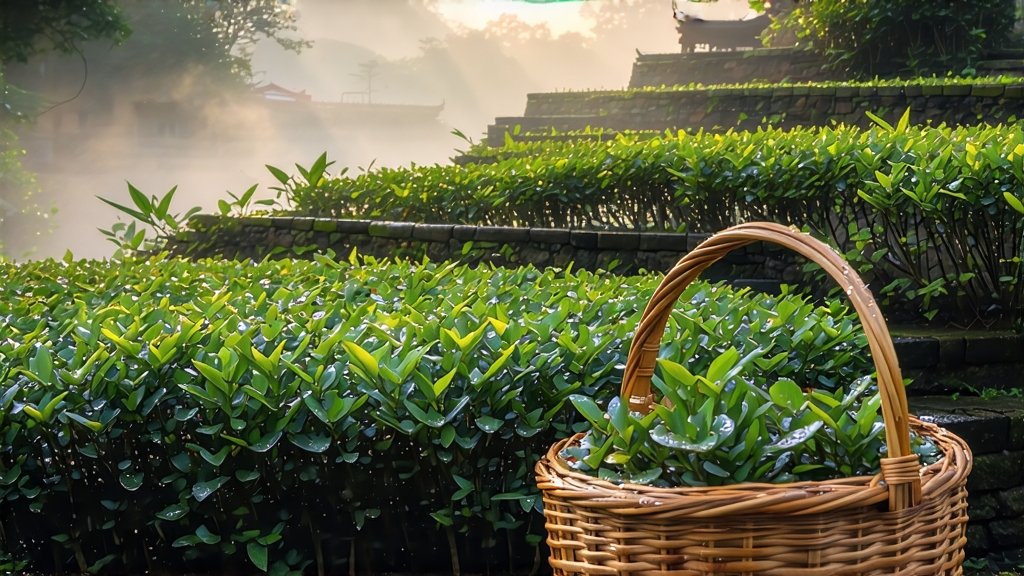
High among the perennially mist-crowned ridges of Ya’an, Sichuan, a tea once reserved for emperors still unfurls its down-covered buds each early April. Meng Ding Huang Ya—literally “Yellow Bud from Meng Summit”—is the least-known yet most aristocratic member of China’s micro-category of yellow tea. While green tea dominates export menus and dark pu-erh fills investment vaults, yellow tea lingers in a twilight of obscurity, produced in tiny lots, often consumed within the province, and rarely unpacked for the international palate. This essay invites the curious drinker to journey from Tang-dynasty tribute lists to the modern tea table, tracing leaf, craft, cup, and sensation in the company of Meng Ding Huang Ya.
-
Historical echoes
Meng Ding (“Summit of Meng”) is the easternmost spur of the Tibetan Plateau, where altitudes climb from 800 m to 1 450 m within a few kilometres. The poet-official Meng Jiao wrote in 814 CE that “the first buds of spring ascend to the Golden Throne,” a reference so specific that scholars identify it as the earliest textual record of Meng Ding tea being levied as tribute. By Song times the imperial court codified four “superior peaks,” and only buds picked before Qingming festival were accepted, carried 1 400 km by relay riders to Bianliang (modern Kaifeng) within nine days. The Ming dynasty saw the innovation of “sealed yellowing,” transforming the naturally green leaf into the golden hue that so delighted the Wanli Emperor that he granted the tea a square vermilion seal reading “Exclusive to the Inner Court.” Republican-era warlords, short on silver, occasionally paid their troops in compressed bricks of Meng Ding Huang Ya, a currency more stable than the provincial banknotes of the day. Thus, for twelve centuries this yellow bud has moved through Chinese history as both luxury and legal tender, a dual identity few cultivars can claim. -
Terroir and cultivar
The garden zone sits just beyond the reach of the Sichuan Basin’s summer furnace, cooled by altitude and by the convergence of the Min and Qingyi Rivers. Annual rainfall exceeds 1 800 mm, but more critical is the 220 fog-bound days that filter UV light into a soft, diffuse glow—ideal for accumulating the amino acid L-theanine while tempering catechin bitterness. Soils are yellow-brown lateritic loam, slightly acidic (pH 4.9–5.4), rich in iron and manganese washed down from Jurassic sandstone. The traditional cultivar is a local seed-propagated population known colloquially as “xiao ye zhong” (small-leaf type), botanically close to Camellia sinensis var. sinensis but with unusually thick cuticles and a higher ratio of soluble sugars. In the 1980s the Sichuan Tea Research Institute selected three clonal lines—Meng Huang 1, 2, and 9—yet most heritage gardens still prefer the heterogeneous seed stock for its complex aromatics. -
The six acts of yellowing
Unlike green tea’s quick kill-green and pu-erh’s microbial post-fermentation, yellow tea occupies a middle path: oxidative non-enzymatic yellowing conducted in a warm, humid micro-environment. The craft is condensed into six Chinese verbs—sha qing, rou nian, men huang, fu chao, zuo xing, bei gan—best rendered as “pan-firing, rolling, sealing, second firing, shaping, low drying.”
a) Pan-firing: Fresh leaves (one bud or one bud and one unfolded leaf, ≤2.5 cm) are tossed in bamboo-leaf-lined woks at 160 °C for three minutes. The goal is partial enzyme deactivation; polyphenol oxidase activity is reduced to roughly 35 % of its original level, leaving enough residual enzymatic potential to drive later transformations.
b) Rolling: While still at 50 °C, the leaf is rolled under palm pressure for eight minutes, rupturing 35–40 % of cell walls without expressing juice, a gentler treatment than green tea’s 60 % target.
c) Sealed yellowing: The critical signature step. The rolled leaf is piled 8 cm deep in oak boxes lined with wet cotton, then placed inside a sealed reed basket. Over 48–72 hours the core temperature drifts